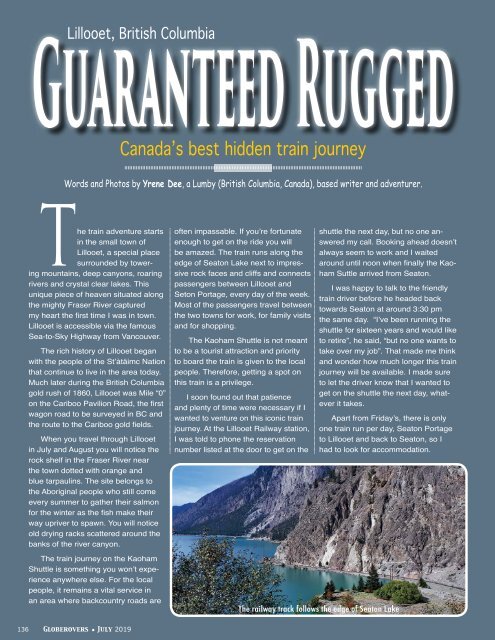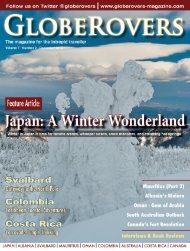Globerovers Magazine, July 2019
GLOBEROVERS MAGAZINE IS NO LONGER ALLOWED TO HAVE MORE THAN 3 ISSUES ON YUMPU UNLESS WE PAY (to provide revenue-generating content to Yumpu!!) SO PLEASE SEE ALL OUR ISSUES FOR FREE ON THESE MAGAZINE PLATFORMS: CALAMEO, MAGZTER, AND ON THE FREE "globerovers" APP. In this 13th issue (July 2019) of Globerovers Magazine, the feature destination is Argentina. We travel from the far north on the border with Bolivia all the way down south to Ushuaia, the gateway to the Antarctic Peninsula. We also have articles about Cyprus and Mauritius Island, Australia, Canada, and we enjoy a colourful New Year Festival with the Naga people in the remote Nagaland region of Myanmar. Photo Essays include the proboscis monkeys and orangutans in Malaysia’s Sabah State on Borneo Island, Peru’s Sacred Valley, and a boat trip down the Li River from Guilin to Yangshuo in China. Furthermore, we have traveller interviews, book reviews, and a lot more! Feedback to editor@globerovers.com. Enjoy!
GLOBEROVERS MAGAZINE IS NO LONGER ALLOWED TO HAVE MORE THAN 3 ISSUES ON YUMPU UNLESS WE PAY (to provide revenue-generating content to Yumpu!!) SO PLEASE SEE ALL OUR ISSUES FOR FREE ON THESE MAGAZINE PLATFORMS: CALAMEO, MAGZTER, AND ON THE FREE "globerovers" APP.
In this 13th issue (July 2019) of Globerovers Magazine, the feature destination is Argentina. We travel from the far north on the border with Bolivia all the way down south to Ushuaia, the gateway to the Antarctic Peninsula.
We also have articles about Cyprus and Mauritius Island, Australia, Canada, and we enjoy a colourful New Year Festival with the Naga people in the remote Nagaland region of Myanmar.
Photo Essays include the proboscis monkeys and orangutans in Malaysia’s Sabah State on Borneo Island, Peru’s Sacred Valley, and a boat trip down the Li River from Guilin to Yangshuo in China.
Furthermore, we have traveller interviews, book reviews, and a lot more!
Feedback to editor@globerovers.com. Enjoy!
Create successful ePaper yourself
Turn your PDF publications into a flip-book with our unique Google optimized e-Paper software.
Guaranteed Rugged<br />
Canada’s best hidden train journey<br />
Lillooet, British Columbia<br />
Words and Photos by Yrene Dee, a Lumby (British Columbia, Canada), based writer and adventurer.<br />
The train adventure starts<br />
in the small town of<br />
Lillooet, a special place<br />
surrounded by towering<br />
mountains, deep canyons, roaring<br />
rivers and crystal clear lakes. This<br />
unique piece of heaven situated along<br />
the mighty Fraser River captured<br />
my heart the fi rst time I was in town.<br />
Lillooet is accessible via the famous<br />
Sea-to-Sky Highway from Vancouver.<br />
The rich history of Lillooet began<br />
with the people of the St’àtäimc Nation<br />
that continue to live in the area today.<br />
Much later during the British Columbia<br />
gold rush of 1860, Lillooet was Mile “0”<br />
on the Cariboo Pavilion Road, the fi rst<br />
wagon road to be surveyed in BC and<br />
the route to the Cariboo gold fi elds.<br />
When you travel through Lillooet<br />
in <strong>July</strong> and August you will notice the<br />
rock shelf in the Fraser River near<br />
the town dotted with orange and<br />
blue tarpaulins. The site belongs to<br />
the Aboriginal people who still come<br />
every summer to gather their salmon<br />
for the winter as the fi sh make their<br />
way upriver to spawn. You will notice<br />
old drying racks scattered around the<br />
banks of the river canyon.<br />
often impassable. If you’re fortunate<br />
enough to get on the ride you will<br />
be amazed. The train runs along the<br />
edge of Seaton Lake next to impressive<br />
rock faces and cliffs and connects<br />
passengers between Lillooet and<br />
Seton Portage, every day of the week.<br />
Most of the passengers travel between<br />
the two towns for work, for family visits<br />
and for shopping.<br />
The Kaoham Shuttle is not meant<br />
to be a tourist attraction and priority<br />
to board the train is given to the local<br />
people. Therefore, getting a spot on<br />
this train is a privilege.<br />
I soon found out that patience<br />
and plenty of time were necessary if I<br />
wanted to venture on this iconic train<br />
journey. At the Lillooet Railway station,<br />
I was told to phone the reservation<br />
number listed at the door to get on the<br />
shuttle the next day, but no one answered<br />
my call. Booking ahead doesn’t<br />
always seem to work and I waited<br />
around until noon when fi nally the Kaoham<br />
Suttle arrived from Seaton.<br />
I was happy to talk to the friendly<br />
train driver before he headed back<br />
towards Seaton at around 3:30 pm<br />
the same day. “I’ve been running the<br />
shuttle for sixteen years and would like<br />
to retire”, he said, “but no one wants to<br />
take over my job”. That made me think<br />
and wonder how much longer this train<br />
journey will be available. I made sure<br />
to let the driver know that I wanted to<br />
get on the shuttle the next day, whatever<br />
it takes.<br />
Apart from Friday’s, there is only<br />
one train run per day, Seaton Portage<br />
to Lillooet and back to Seaton, so I<br />
had to look for accommodation.<br />
The train journey on the Kaoham<br />
Shuttle is something you won’t experience<br />
anywhere else. For the local<br />
people, it remains a vital service in<br />
an area where backcountry roads are<br />
The railway track follows the edge of Seaton Lake<br />
136<br />
<strong>Globerovers</strong> •· <strong>July</strong> <strong>2019</strong>





